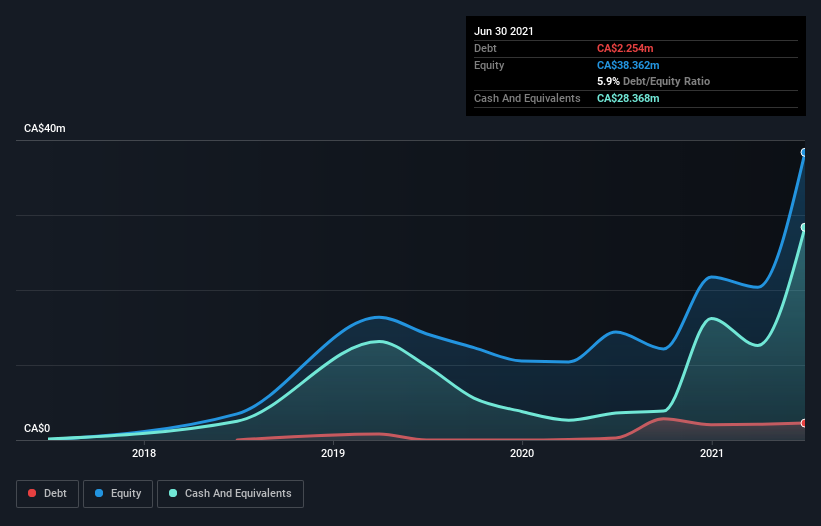Legendary fund manager Li Lu (who Charlie Munger backed) once said, 'The biggest investment risk is not the volatility of prices, but whether you will suffer a permanent loss of capital.' So it seems the smart money knows that debt - which is usually involved in bankruptcies - is a very important factor, when you assess how risky a company is. We note that CubicFarm Systems Corp. (TSE:CUB) does have debt on its balance sheet. But the real question is whether this debt is making the company risky.
When Is Debt A Problem?
Generally speaking, debt only becomes a real problem when a company can't easily pay it off, either by raising capital or with its own cash flow. If things get really bad, the lenders can take control of the business. However, a more usual (but still expensive) situation is where a company must dilute shareholders at a cheap share price simply to get debt under control. Of course, the upside of debt is that it often represents cheap capital, especially when it replaces dilution in a company with the ability to reinvest at high rates of return. The first step when considering a company's debt levels is to consider its cash and debt together.
See our latest analysis for CubicFarm Systems
What Is CubicFarm Systems's Debt?
As you can see below, at the end of June 2021, CubicFarm Systems had CA$2.25m of debt, up from CA$265.1k a year ago. Click the image for more detail. However, its balance sheet shows it holds CA$28.4m in cash, so it actually has CA$26.1m net cash.

How Healthy Is CubicFarm Systems' Balance Sheet?
The latest balance sheet data shows that CubicFarm Systems had liabilities of CA$8.88m due within a year, and liabilities of CA$3.35m falling due after that. Offsetting these obligations, it had cash of CA$28.4m as well as receivables valued at CA$1.77m due within 12 months. So it actually has CA$17.9m more liquid assets than total liabilities.
This surplus suggests that CubicFarm Systems has a conservative balance sheet, and could probably eliminate its debt without much difficulty. Simply put, the fact that CubicFarm Systems has more cash than debt is arguably a good indication that it can manage its debt safely. The balance sheet is clearly the area to focus on when you are analysing debt. But you can't view debt in total isolation; since CubicFarm Systems will need earnings to service that debt. So if you're keen to discover more about its earnings, it might be worth checking out this graph of its long term earnings trend.
In the last year CubicFarm Systems had a loss before interest and tax, and actually shrunk its revenue by 76%, to CA$1.3m. To be frank that doesn't bode well.
So How Risky Is CubicFarm Systems?
By their very nature companies that are losing money are more risky than those with a long history of profitability. And the fact is that over the last twelve months CubicFarm Systems lost money at the earnings before interest and tax (EBIT) line. Indeed, in that time it burnt through CA$20m of cash and made a loss of CA$25m. Given it only has net cash of CA$26.1m, the company may need to raise more capital if it doesn't reach break-even soon. Even though its balance sheet seems sufficiently liquid, debt always makes us a little nervous if a company doesn't produce free cash flow regularly. The balance sheet is clearly the area to focus on when you are analysing debt. However, not all investment risk resides within the balance sheet - far from it. These risks can be hard to spot. Every company has them, and we've spotted 4 warning signs for CubicFarm Systems (of which 1 can't be ignored!) you should know about.
At the end of the day, it's often better to focus on companies that are free from net debt. You can access our special list of such companies (all with a track record of profit growth). It's free.
New: AI Stock Screener & Alerts
Our new AI Stock Screener scans the market every day to uncover opportunities.
• Dividend Powerhouses (3%+ Yield)
• Undervalued Small Caps with Insider Buying
• High growth Tech and AI Companies
Or build your own from over 50 metrics.
This article by Simply Wall St is general in nature. We provide commentary based on historical data and analyst forecasts only using an unbiased methodology and our articles are not intended to be financial advice. It does not constitute a recommendation to buy or sell any stock, and does not take account of your objectives, or your financial situation. We aim to bring you long-term focused analysis driven by fundamental data. Note that our analysis may not factor in the latest price-sensitive company announcements or qualitative material. Simply Wall St has no position in any stocks mentioned.
Have feedback on this article? Concerned about the content? Get in touch with us directly. Alternatively, email editorial-team (at) simplywallst.com.
About TSXV:CUB
CubicFarm Systems
A local chain agricultural technology company, provides automated on site commercial scale food and livestock feed technologies in Canada.
Medium-low risk with weak fundamentals.
Similar Companies
Market Insights
Community Narratives



